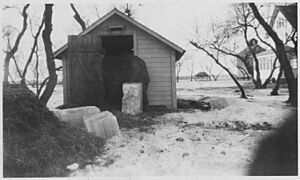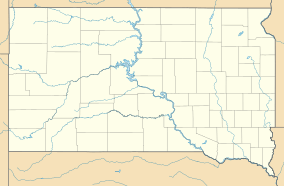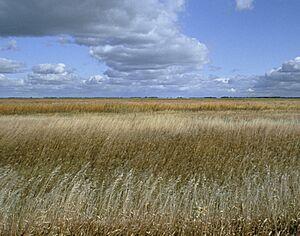Sand Lake National Wildlife Refuge facts for kids
Quick facts for kids Sand Lake National Wildlife Refuge |
|
|---|---|
|
IUCN Category IV (Habitat/Species Management Area)
|
|
| Location | Brown County, South Dakota, U.S. |
| Nearest city | Aberdeen, S.D. |
| Area | 21,498 acres (87 km2) |
| Established | 1935 |
| Governing body | U.S. Fish and Wildlife Service |
| Website | Sand Lake NWR |
| Designated: | 3 August 1998 |
| Reference #: | 957 |
The Sand Lake National Wildlife Refuge is a special place in northeastern South Dakota, U.S. It's like a huge nature park, managed by the United States Fish and Wildlife Service. This refuge was created in 1935 to protect important wildlife.
It's known as a "wetland of international importance" because of a special agreement called the Ramsar Convention. It's also a "Globally Important Bird Area." This means it's super important for birds all around the world! More than 260 different kinds of birds live here, including many that migrate (travel long distances). It's even home to the world's biggest group of nesting Franklin's gulls.
Contents
Protecting Wildlife: How Sand Lake Began
In the late 1800s, farmers settled in the Sand Lake area. Their farming methods unfortunately harmed the homes of many wild animals. This caused a big drop in the number of waterfowl, like ducks and geese.
To help the animals, the U.S. Congress decided to create the Sand Lake National Wildlife Refuge in 1935. Its main goal was to protect the places where wildlife live and raise their young.
Managing the Refuge: Who Helps the Animals?
The Sand Lake National Wildlife Refuge covers about 21,498 acres (87 square kilometers) of land. It's part of a bigger system called the National Wildlife Refuge System. This system has over 550 refuges across the U.S.
The U.S. Fish and Wildlife Service manages all these refuges. This service is part of the Department of the Interior, a government group.
Helping Wetlands and Grasslands
The refuge also runs the Sand Lake Wetland Management District. This program helps protect wetlands and grasslands on private land. It's the largest program of its kind in the country, working in eight different counties.
About 75,000 people visit the Sand Lake Refuge every year. They come to see the amazing wildlife and beautiful nature.
Sand Lake's Important Wetlands
Sand Lake National Wildlife Refuge is recognized as one of the world's most important wetlands. This is thanks to the Ramsar Convention, an international agreement signed in 1971. The U.S. joined this agreement in 1987.
Sand Lake became a Ramsar site on August 3, 1998. It covers about 8,700 hectares (21,498 acres). It's known as a "large freshwater cattail marsh."
Why are these Wetlands so Special?
These wetlands are super important for many bird species. They are a "critical nesting and staging habitat." This means birds come here to build nests and raise their babies. It's also a place where tens of thousands of migrating waterfowl stop to rest and eat.
The wetlands are a popular spot for visitors. Thousands of people come each year to enjoy the natural beauty and watch the birds.
Amazing Animals and Plants at Sand Lake

Sand Lake is home to a huge variety of wildlife. You can find over 260 different kinds of birds here! There are also 40 types of mammals and many other creatures. WildBird Magazine even called Sand Lake one of the top 15 places in North America for bird watching.
Birds You Might See
You'll often spot Mallard ducks, wood ducks, and Canada geese. Other common birds include Western grebes, white pelicans, and snow geese.
One of the most special residents is the Franklin's gull. Sand Lake has the largest group of nesting Franklin's gulls in the entire world!
A Globally Important Bird Area
The American Bird Conservancy has named Sand Lake National Wildlife Refuge a "Globally Important Bird Area." This is a big honor! There are about 500 such sites in the U.S. and around 3,500 worldwide. In South Dakota, Sand Lake is one of only two such sites. The other is the Fort Pierre National Grassland.
Waterways and Lakes
The main river in the refuge is the James River. This river feeds into two important lakes: Sand Lake and Mud Lake. These lakes were actually created by the Civilian Conservation Corps during the New Deal Era. They built dams on local rivers to form these watery habitats.
Images for kids
-
Cutting ice at Sand Lake National Wildlife Refuge with the Civilian Conservation Corps.
-
Sand Lake National Wildlife Refuge wetlands.






